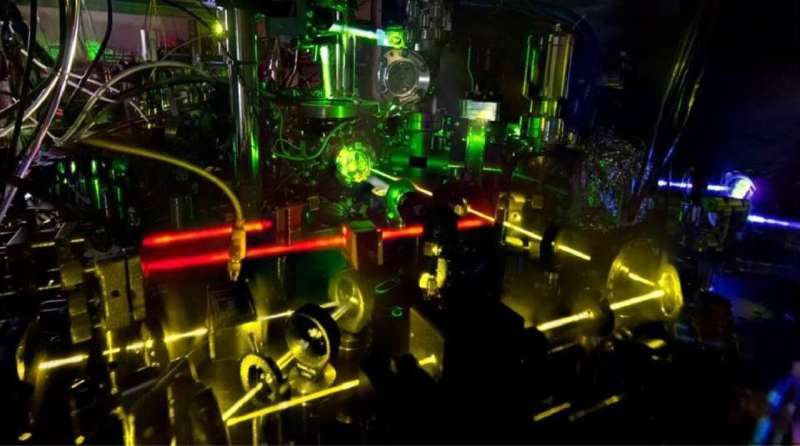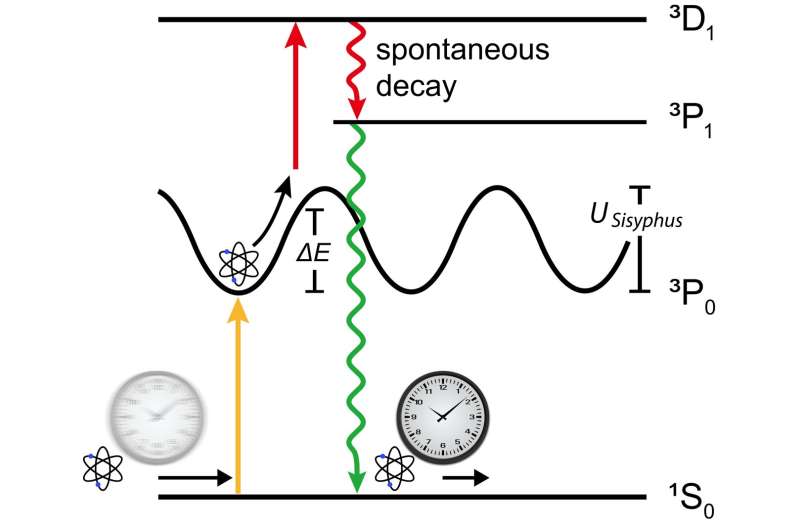August 29, 2024 feature
This article has been reviewed according to Science X's editorial process and policies. Editors have highlighted the following attributes while ensuring the content's credibility:
fact-checked
peer-reviewed publication
trusted source
proofread
New Sisyphus cooling technique could enhance precision of atomic clocks

Researchers in the Neutral Atom Optical Clocks Group at the National Institute of Standards and Technology (NIST), University of Colorado and Pennsylvania State University recently devised a new sub-recoil Sisyphus cooling technique that could help to improve the precision of atomic clocks.
This technique, outlined in a paper published in Physical Review Letters, was initially used to create a highly performing ytterbium optical lattice clock, but it could also aid in the development of other clocks and quantum metrology tools.
"Precision spectroscopy is a very broad research field with a long history," Chun-Chia Chen, co-author of the paper, told Phys.org. "Atomic physicists carry out spectroscopy studies on objects ranging from atoms and ions to molecules and more. Perhaps surprisingly, high precision spectroscopy was also done on anti-matter, which is an active field of research currently being explored at CERN."
While trying to improve the accuracy and precision of atomic clocks, Chen and his colleagues at NIST stumbled upon a paper that outlined a new scheme for the Sisyphus laser cooling of hydrogen and anti-hydrogen. Drawing inspiration from this scheme, they set out to devise a similar cooling approach that could advance the performance of their atomic clocks.
Atomic clocks are timekeeping devices that reference a frequency to the oscillatory motion of atoms. The operation of these clocks relies on high-precision spectroscopy techniques addressing atomic states with long lifetimes and an ultra-narrow transition linewidth between these states, which is typically at the sub-Hz level.
"Traditionally, we use this ultra-narrow spectroscopy feature for frequency stabilization purposes, which serves as the core idea for current state-of-the-art frequency standards and optical atomic clocks," Chen explained. "However, prior to executing high precision spectroscopy, we utilize the ultra-narrow excitation together with another quantum engineering tool for the implementation of Sisyphus cooling. "

Essentially, Chen and his colleagues strategically engineered the energy shift of their excited clock state following a periodically modulated pattern. This method allowed them to precisely control the location where a clock line excitation happens within their Sisyphus cooling process.
"More specifically, we configure the excitation condition such that it occurs preferably at the position corresponding to the bottom of the periodic potential landscape," Chen said. "Once excited, atoms lose their kinetic energy by climbing the potential and preferentially exit the potential landscape away from the potential's minimum. The cooling is realized after repetitively climbing the energy potential."
As part of their recent study, the researchers demonstrated their Sisyphus cooling scheme by leveraging the ultra-narrow transition of an Ytterbium-based optical lattice clock. However, the same approach should theoretically also be applicable to other systems equipped with narrow linewidth transitions.
"For the last two decades, the goal of realizing high precision clock spectroscopy of neutral atoms has been best achieved by creating identical trapping conditions for atoms in both the ground state and the excited clock state," Chen explained.
"This is done by engineering a trap formed by lasers into a standing wave and that operates at what we call a magic-wavelength. In this situation, a difference in the trapping potential felt by the atoms in the two atomic states is essentially an enemy to the realization of a high-precision clock spectroscopy."
Most recent efforts aimed at advancing clock spectroscopy have therefore explored strategies to minimize the trap potential difference between the ground state and excited clock state. To tackle this challenge, Chen and his colleagues focused on enhancing the cooling of samples before carrying out the high precision clock spectroscopy.
"To realize improved cooling during sample preparation before executing the clock spectroscopy, we momentarily introduced an engineered spatially dependent excited state shift, which introduced more, not less, trap potential difference for the two clock states," Chen said.
"Doing so allowed us to realize the Sisyphus cooling mechanism, which in turn improved the sample condition later for better clock spectroscopy with less trap potential difference. Furthermore, the cooler temperatures helped us use shallower traps on the atoms, which also reduced this difference."
The new Sisyphus cooling technique devised by this team of researchers could soon help to improve the precision of other optical clock systems. In addition, it could be used to cool samples for other emerging technologies, including quantum information processing and computing systems. In their next studies, these researchers plan to continue using their Sisyphus cooling technique to improve the accuracy of optical lattice clocks developed at NIST.
"The additional cooling allows us to create atomic ensembles with more uniform conditions inside the magic-wavelength standing-wave laser trap," added researcher Andrew Ludlow. "This in turn allows us to more carefully and precisely characterize small effects of the trapping laser on the clock frequency.
"Furthermore, the lower temperatures allow us to hold the atoms in even weaker laser traps, where unwanted trapping effects are even smaller. After some careful measurements we are currently working on, all of this will translate to improved clock accuracy."
More information: Chun-Chia Chen et al, Clock-Line-Mediated Sisyphus Cooling, Physical Review Letters (2024). DOI: 10.1103/PhysRevLett.133.053401. On arXiv: DOI: 10.48550/arxiv.2406.13782
Journal information: Physical Review Letters , arXiv
© 2024 Science X Network





















